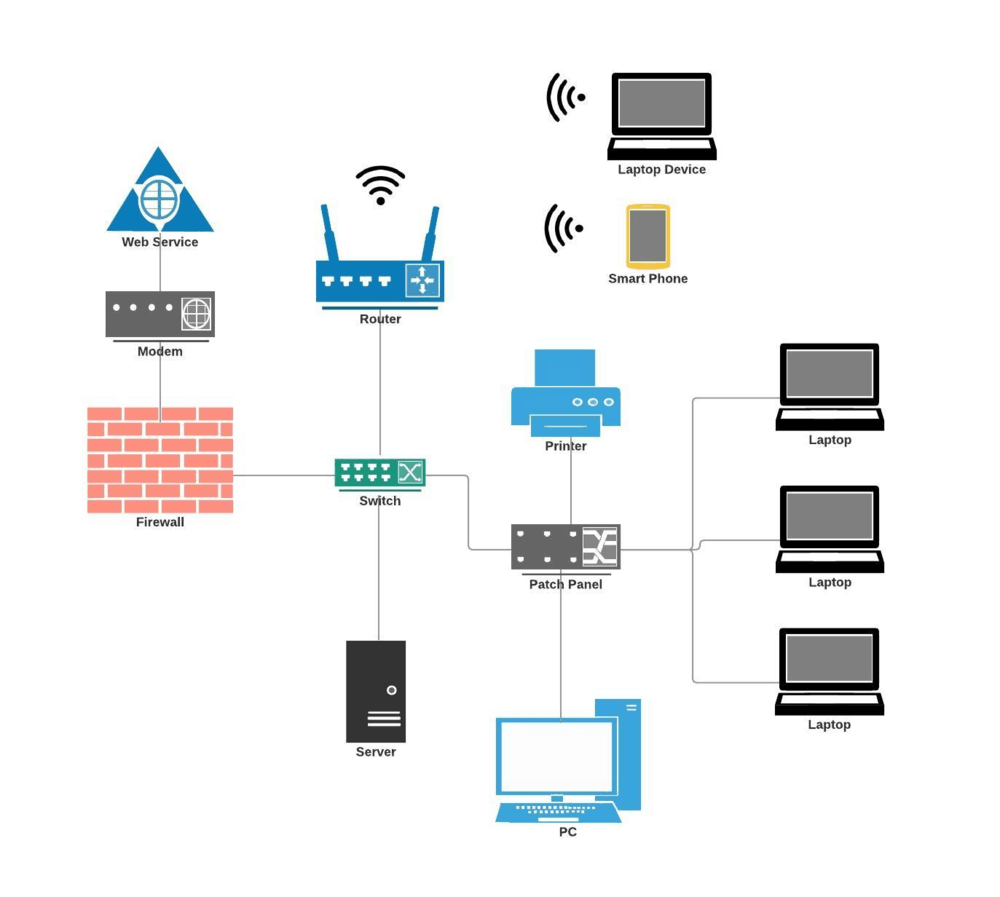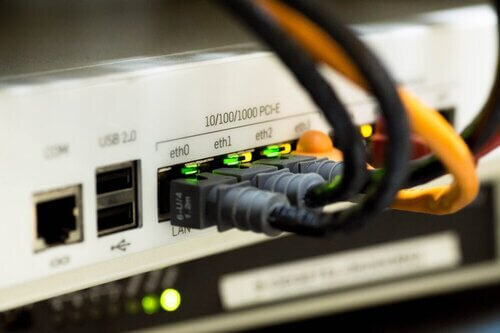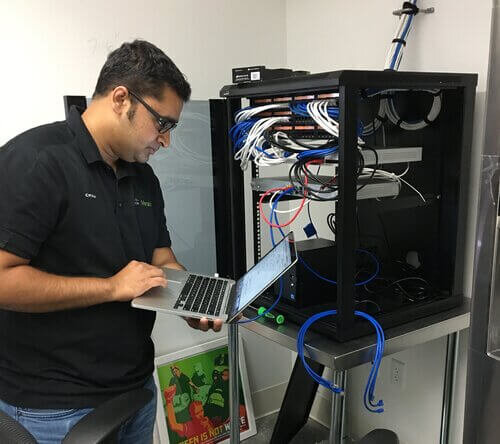why do you need to consider what the network and computer are like when creating your procedures
Network Blueprint from a small business
Your computer network infrastructure is the backbone of your business. All your devices, applications, software, and most of your piece of work are supported by or built upon your computer network. Therefore, planning, design, purchasing hardware, and security of a concern reckoner network need to be a high priority for your business organization.
To build a figurer network for your company, you lot need to consider quite a few things. Making a computer network run efficiently in a business concern environment is very different from setting upward a habitation or domestic network. Concern network pattern has a loftier degree of complexity and security challenges. While the type of network for your concern will depend on your needs simply the components of your estimator network will remain the same.
Here is the listing of devices needed to set a estimator network for your business:
-
Modem
-
Router
-
Firewall
-
Switch
-
LAN Cable / Patch Cablevision
-
Admission Point
-
Repeater
-
Patch Panel
Here'due south a typical small business organisation network setup case:

And here'southward a description of a simple function network setup: The cyberspace connection comes via a cable from your Internet service provider (isp). This cable connects to your router. The firewall filters the traffic transmitted through the cablevision, which then connects to a switch. All your network devices then gain access to the internet by connecting to that switch.
At present, let's await at each of the network devices in detail. We won't go deep into the technical details, rather we will focus on what you need to know to cull the right equipment required for designing and setting up the best possible network for your business.
Main hardware components of an office computer network

-
Modem
A modem, short for modulator-demodulator, is a hardware component of your network that helps your computer and other devices to connect with the cyberspace. This device converts the digital data that the reckoner understands to analog information that is transmitted over the cable.
The modems that you normally run across are almost probable cablevision modems supporting DOCSIS (Data Over Cablevision Service Interface Specification), which is used to transmit the internet over hybrid cobweb-coaxial cables. This way y'all can go Television receiver, cable internet, digital telephone line over the same cablevision.
With the growing use of cobweb optic connections, modems are becoming obsolete. Cobweb optic cables are able to transmit higher bandwidth over longer distances. Since y'all require a high data transfer charge per unit in your office, it is more probable that you will use a fiber optic connection. In this case, you will not require a modem to exist a part of your network.
- Router
A router is that component of your network hardware that transfers packets of information betwixt networks. In simple terms, it transfers data from the internet cable to your device.

In a elementary network connection, the net cable connects with your router allowing information technology to transmit and receive information from the internet. Other devices in your office network connect to the router using an Ethernet switch in betwixt and therefore proceeds access to the internet.
We will non get into the technical details of how a router works. That is not the intent of this blog. Instead, we will focus on what you need to consider before choosing a router for your part network.
How to choose a router for your business organization?
Most ISPs (Internet Service Providers) usually give you a free router when you buy a subscription. However, these routers are non the all-time for your usage. Y'all will definitely have to buy ane and hither's what yous should consider before choosing a router:
-
Number of devices on your network
Counting the number of devices continued to your network is non always elementary. Desktops, laptops, and mobile devices aren't the only devices on your network. Hither's what you need to include in your calculation:
-
Desktops
-
Laptops
-
Tablets
-
Smartphones
-
Network Printers
-
VoIP phone system
-
Conference room equipment
-
POS systems
-
IP Cameras
-
Guest Devices

If the total number of devices connected to your network is 20 or more, you should invest in commercial or business-grade Wi-Fi equipment because consumer-grade or abode routers can handle merely a limited number of devices. You can likewise hardwire some of your devices to free up the speed on wireless devices. Even so, investing in a commercial router volition ease your network immensely.
-
Interference from neighbor's Wi-Fi
If your office is located in a densely populated area such as downtown San Francisco, information technology is very likely that your Wi-Fi volition face up interference from your neighbor's Wi-Fi. That's right, it happens all the time. You lot can utilise a dual-band router to mitigate the interference.
You can use the 2.four GHz band for IoT devices while reserving the 5 GHz band for mobile devices such as laptops. This helps keep the 5 GHz band gratuitous of congestion. In add-on, since the 5 GHz ring has a shorter range, it allows yous to apply additional access points without the risk of interference in the high congestion airspaces. Near enterprise-grade Wi-Fi equipment simultaneously uses the 2.iv GHz and v GHz bands and automatically steers your devices to the best option available.

-
Guest Wi-Fi Requirement
If you intend to have guest users on your network, you should create a separate SSID (service set identifier) for guests. This gives you pregnant flexibility besides equally security as yous can give your guests internet access without giving them access to your internal network. The SSIDs can also exist assigned different policies, encryption, authentication, etc. in order to ensure an added level of security. Business-course equipment supports multiple SSIDs.
Choosing the right router is critical in building a reliable wireless network. Therefore, you should pay special attention to the above requirements.
- Firewall

A firewall is a security system for your estimator network. Information technology monitors and controls the incoming and approachable network traffic based on security rules set by you. In other words, a firewall is a filter, between your internal network and the external network such equally the internet, that protects your concern network from unauthorized external access.
Does your network need a firewall?
Fifty-fifty though computers come with an inbuilt software firewall, your business isn't safe with that unmarried flimsy safe internet. Network infrastructure devices are typical targets for cyber attackers and without a dedicated firewall, your network and all connected devices are vulnerable to hackers.
A defended hardware firewall gives your network a much-needed added layer of protection. The hardware firewall comes with advanced features such every bit VPN, Remote Access, and Advanced Web filtering. It is like to a router in that information technology can handle a limited number of users. Therefore, make certain to get a firewall with enough capacity for future growth.
A commercial-grade router unremarkably comes with inbuilt firewall capabilities so you might not need to buy dissever firewall hardware. Just make sure that y'all double-bank check this since it is critical for your network security.
- Switch

A switch is an of import foundation element of your office network. It is a network device that allows other devices on the network to communicate and share data. You volition have PCs, printers, NAS (network-attached storage) devices, servers, VoIP (Vocalisation over Internet Protocol), etc. on your network and the switch ties these devices together into your network.
On your home, yous don't see a switch because the wireless router that you use is a combination of a wireless router, an admission point, and a switch. We will talk about access points in the following section. So information technology may get a little confusing if you compare your dwelling network with your office network. You lot just need to remember that the function of a switch is different than a router, which connects together different networks. For almost businesses, the router connects your network with the cyberspace. While the switch connects unlike devices within your network.
How to choose a switch for your part network?
For small and medium businesses, in that location are three types of network switches to choose from. These types are based on configuration options and are as follows:

-
Unmanaged Switch
An unmanaged switch is the simplest and most basic kind of switch. Information technology's simple considering you lot can use it out of the box equally it doesn't need any configuration. Unmanaged switches are less expensive but lack advanced features. They are best for small offices that accept unproblematic networks.
-
Managed Switch
A managed switch gives you control over the operation of the switch. You can configure your switch to determine how your network consumes an internet connection. You can configure the switch via a CLI (command line interface), SNMP (Uncomplicated Network Management Protocol), or a web interface.
For example, a managed switch allows you to set port bandwidth, and create or modify VLANs (Virtual Local Expanse Networks). Managed switches are more expensive and require some technical knowledge for using them effectively. Another key reward is that they can be managed remotely and hence are very useful for large offices and satellite locations.
- Patch Cable, Patch cord, LAN Cable

A solid underlying wired network goes a long way in ensuring a fast wireless network. Your cables are responsible for delivering sufficient bandwidth to your admission points without which your WiFi network volition become sluggish. Therefore, using the recent cable standards such as CAT6 for your LAN wiring would be a expert investment. This also allows you to connect certain devices such every bit printers, IP cameras, etc to the wired network thereby freeing the spectrum from wireless dependent devices such as laptops, and mobile devices. Also plan on running two cables to each wireless access point because electric current and future standards will need the extra wired bandwidth.
The Best Network For Pocket-sized Business
This is the showtime office of our web log on network setup for a small business. Then far, we accept discussed the function of and the requirements for your business network with respect to the following network devices:
-
Modem
-
Router
-
Firewall
-
Switch
-
LAN Cablevision / Patch Cable
In our next web log, How To Build A Reckoner Network For Your Pocket-size Business organisation - Part 2, we will discuss the following:
-
Admission Point
-
Repeater
-
Patch Panel
-
PoE (Power over Ethernet)
-
Cablevision Management, and
-
Network Security Implementation
Feel free to reach out to us if you have whatever queries or need help designing and building a network for your company.
If yous would like to be notified when the next part of this weblog is published, make sure to subscribe to our mailing list.
If you lot liked this blog, delight share it with your friends
iv Comments
Source: https://www.itjones.com/blogs/2020/3/15/how-to-build-a-computer-network-for-your-small-business-part-1-the-basics
Post a Comment for "why do you need to consider what the network and computer are like when creating your procedures"